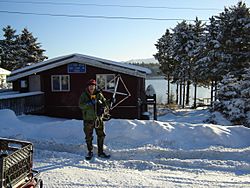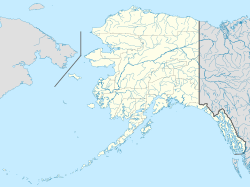Port Lions, Alaska facts for kids
Quick facts for kids
Port Lions
Masiqsirraq
|
|
|---|---|

A radio scientist from Stanford University at the Port Lions post office.
|
|
| Country | United States |
| State | Alaska |
| Borough | Kodiak Island |
| Incorporated | January 24, 1966 |
| Area | |
| • Total | 8.73 sq mi (22.60 km2) |
| • Land | 4.99 sq mi (12.91 km2) |
| • Water | 3.74 sq mi (9.69 km2) |
| Elevation | 98 ft (30 m) |
| Population
(2020)
|
|
| • Total | 170 |
| • Density | 34.10/sq mi (13.16/km2) |
| Time zone | UTC-9 (Alaska (AKST)) |
| • Summer (DST) | UTC-8 (AKDT) |
| ZIP code |
99550
|
| Area code | 907 |
| FIPS code | 02-63610 |
| GNIS feature ID | 1408218 |
Port Lions is a small city located on Kodiak Island in Alaska, USA. Its name in the native Alutiiq is Masiqsirraq. In 2010, about 194 people lived there.
Port Lions was built for people from two nearby villages, Ag'waneq and Port Wakefield. Their original homes were destroyed by a huge earthquake in 1964. The city was built with help from the United States government and a group called the Lions Club. The city was named "Port Lions" to honor the Lions Club for their help.
Where is Port Lions?
Port Lions is located on Kodiak Island, which is part of Alaska. You can find it at these coordinates: 57°52′5″N 152°52′48″W / 57.86806°N 152.88000°W.
The city covers a total area of about 22.6 square kilometers (8.73 square miles). Most of this area is land, about 12.91 square kilometers (4.99 square miles). The rest, about 9.69 square kilometers (3.74 square miles), is water.
Who Lives in Port Lions?
The number of people living in Port Lions has changed over the years.
| Historical population | |||
|---|---|---|---|
| Census | Pop. | %± | |
| 1970 | 227 | — | |
| 1980 | 215 | −5.3% | |
| 1990 | 222 | 3.3% | |
| 2000 | 256 | 15.3% | |
| 2010 | 194 | −24.2% | |
| 2020 | 170 | −12.4% | |
| U.S. Decennial Census | |||
Port Lions first appeared in the U.S. Census in 1970. The city was officially formed in 1966.
In 2000, there were 256 people living in Port Lions. The average age of people in the city was 36 years old.
Learning and Science
Stanford University has a special scientific radio receiver in Port Lions. This equipment helps scientists study very low frequency radio signals.
Children in Port Lions attend the Port Lions School. This school teaches students from kindergarten all the way through 12th grade. It is managed by the Kodiak Island Borough School District.
See also
 In Spanish: Port Lions para niños
In Spanish: Port Lions para niños


